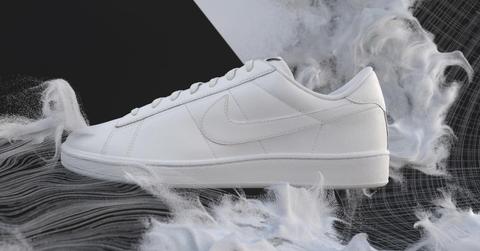Nike Turns Wasted Leather Into Eco-Friendly 'Flyleather' Shoes
Nike is looking to improve the leather manufacturing process by recycling up to 30 percent excess cow hide and turning into Flyleather. With a powerful hydro system and synthetic fibers, they can create a premium leather that's much more sustainable.
Updated May 25 2019, 1:00 a.m. ET
People in the textile industry are becoming more aware of the waste they create and are looking toward methods to recycle it. Nike, the famous athletic apparel company, can end up wasting nearly a third of cow’s hide material when creating leather for their shoes. To trim the waste, the company is recycling the product into a different kind of leather.
In a collaboration with E-Leather from the United Kingdom, Nike has created shoes made of a new Flyleather material. Around half of it comes from the discarded cowhide that’s turned into fiber. That is mixed in with synthetic fibers and it’s fused together with a high-powered water process -- the liquid comes out so strong it morphs the two into the Flyleather material.
E-Leather has done a similar process to create seat covers for the transportation industry over in the UK. Since the company began the process in 2007, they’ve been able to save over 5,700 tons of traditional leather from being wasted -- exactly zero of their waste has gone to the landfills -- and 95 percent of the water used is recycled.
Flyleather is also very sustainable due to the limited water it uses in the first place. According to Nike, creating the new material uses only 10 percent of the amount needed for traditional leather. This brings their carbon footprint down by a whopping 80 percent. It's also 40 percent lighter and five times more durable compared to full-grain leather. The product is produced and cut on a roll, which improves the cutting method.
Traditional leather manufacturing has been a significant environmental hazard. Lots of energy is used along with a significant mixture of hazardous chemicals. Even worse, there’s now awareness of how dangerous the process of treating these skins and hides are. Also known as tanning, this method also impacts the people who work and live around it.
“We've always struggled to find ways to address the leather environmental impact,” Hannah Jones, Nike’s Chief Sustainable Officer, told Wired. “You can take what would've gone to a landfill and put it straight back into the material, so it’s a continuous cycle.”
There’s also no sacrifice when it comes to using Flyleather. In fact, Nike boasts that it feels and looks like premium leather. According to Fast Company, Nike’s Flyknit shoe brand has “reduced more than 3.5 million pounds of waste since they were introduced in 2012.”
Clothing produces a ridiculous amount of waste, both in how its made and what is thrown away annually after wearing out. It’s even worse when it comes to creating traditional leather, which is extremely hazardous to the environment and people. Nike’s new approach is a great step in the sustainable direction.
